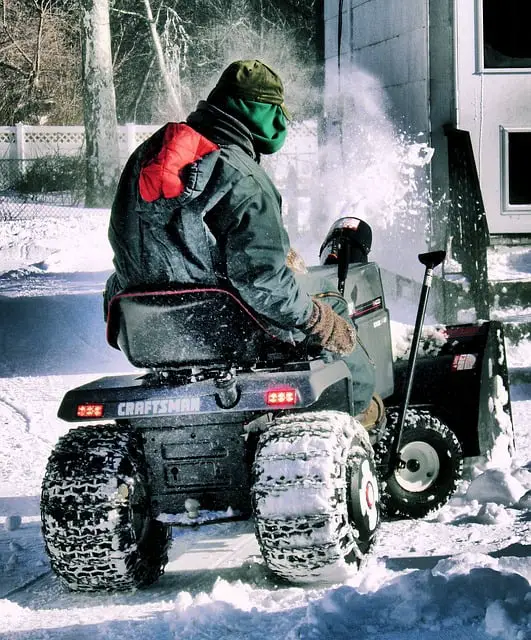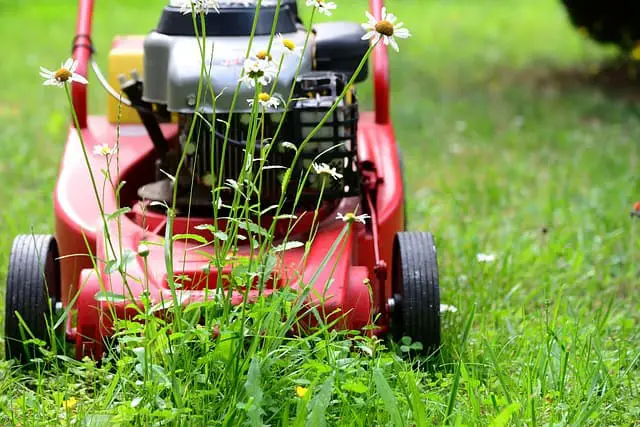Using PAM on a snowblower is a great idea. It is entirely harmless to the snowblower, and it thwarts snow and ice from building up in the chute and on the auger. It is cheaper than high-priced sprays marketed for the same purpose and makes clearing snow a lot easier and quicker.
Winter for me means hot breakfasts and snowy landscapes. I love seeing a fresh snowfall. I spray skillets with PAM and fry some potatoes, onions, and peppers with scrambled eggs. No, wait! Don’t put the PAM away. We’re going to need it. We’ll spray it on the snowblower before we run it. Huh? You don’t? I use it every time. Check it out…
Why Use PAM On A Snowblower?
Sometimes new snow is heavy with moisture. You know, the kind that makes good snowmen and snowballs. It isn’t like the dryer, powdery snow. This stuff packs!
It also packs inside the snowblower. Clumps of it stick to the metal auger and sides of the discharge chute. More snow sticks to that snow, and pretty soon, the snowblower is clogged and out of commission.
What Difference Does PAM Make?
PAM is good for more than keeping fried foods from sticking. PAM prevents sticky liquids or food from accumulating on measuring cups and spatulas. PAM will even prevent mud from sticking to your shoes!
It stands to reason, then, that PAM will keep snow from sticking to your snowblower. It makes the difference between quickly getting in from the cold and standing in the snow for another hour chipping ice from your snowblower with a putty knife.
How Does It Work?
Imagine you are climbing a rock wall. About halfway up, you are almost hugging the wall, hoping you don’t fall off. Now, imagine that same wall but spray it with PAM. How far up do you think you would get?
Get it? The rock wall is the snowblower, and you are the snow. The snow won’t have any more luck on the snowblower than you do on the rock wall once PAM is applied.
Why Does It Work?
At first glance, the surface of an auger and the discharge chute look smooth. Even when the polish of being new wears off, they still seem nice and smooth. Yes, but put them under a microscope (Good luck making that happen, by the way) and look again.
The closer you look, the more that smooth surface appears pitted and porous. Minute scratches you can’t even see with the naked eyes show up as ruts in the metal. Rust spots show up as craters. Scratches visible to the naked eyes look more like jagged rocky-top canyons.
Imagine these surfaces having moisture-laden snow forced against them—the snow packs into the pores, pits, and scratches on the surface. As more of it packs together, it gets heavier and begins to squeeze out the moisture content or water.
What Happens Without PAM?
The water floods into the pits and scratches like cold mountain streams feeding lakes and rivers. It encounters temperatures below freezing, unlike when it had some protection from the cold by a blanket of snow around it and freezes.
Then, it expands. Do you remember how hard it is to sometimes get an ice cube out of the ice cube tray? Ice and snow are just as stubborn on your snowblower. Once they get a good hold, they are there to stay.
The process doesn’t stop. More water squeezes out, and ice forms from the bottom up. Soon, that perfect coat of fresh snow turns your snowblower into an ugly slag of ice, and all progress comes to a cold, hard stop.
PAM won’t let that happen.
How Does It Do That?
In effect, PAM keeps snow from sticking. Let’s look a bit closer at how it does that.
PAM is a blend of canola, palm, and coconut oil with lecithin.
Palm and coconut oil melts in summer temperatures then becomes solid in the winter. Canola oil, however, does not turn solid until it is less than 14°F.
Now, lecithin is an emulsifier. You can say it helps the oil and water play together nicely.
You spray your discharge chute and auger with PAM, the palm and coconut oil flow over and onto the porous surface, then they turn solid. Remember all those pits and canyons? They are clogged, so water can’t even get into them, much less freeze in them.
Now, here comes the snow! The visible surfaces of the auger and discharge chutes have a thin filmy coating of lecithin on them. On top of that is some liquid canola oil, but it is cold and a bit sluggish, so it’s not going anywhere any too fast.
Don’t Keep Me In Suspense! What Happens?
At first, everything happens like before. The heavy snow clumps up and gets packed in. As it accumulates, its weight squeezes out water.
There are no pits and canyons for the water to fill. It has nowhere to go. However, there is a thin coat of lecithin. As an emulsifier, it attracts both canola oil and water. It enables them to mix. The resulting mixture ends up having a lower freeze point than water.
The moisture in the snow has lost its hand-holds on the rock wall. The water combines with the oil because the film of lecithin attracts them both, no ice can form and get a hand-hold, and the snow blows up, out, and over into the neighbors’ yards.
Now, it’s time for another cup of coffee.
Does Anything Work Better Than PAM?
Some people use ski wax on the inside of the discharge chute and bucket. It lasts and is incredibly slick in cold weather.
Some people swear by WD-40 or silicone spray. I also heard about a product called Fluid Film. I guess it works well, but it runs somewhere around $15 a can.
I swear by PAM at $3 a can.
Another viable option is to use a ceramic coating used by car dealers to make it non-stick. Watch this video to see it in action.
Meta Description
Use PAM on a snowblower. Find out why it’s the best way to keep snow and ice from shutting the job down.


